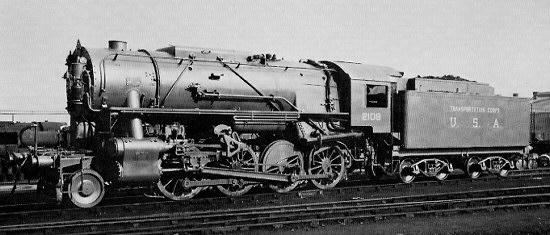Globe Trotting Locomotives by
Patrick J. Durand
The many sisters of the Alaska Railroad class 550 consolidations
International Distribution of s-160 class locomotives.
Information here is extracted from Allied Military Locomotives Of The Second World War by R. Tourret.
During the Second World War the United States Army Transport
Corps (USATC) was called upon to provide a heavy freight steam locomotive
for use in Europe and Africa. Many of the locomotives were to be stockpiled
in Britain in the lead up to the D-Day invasion of Europe, and some were to
be loaned to British railway companies to help with the war effort.
The result was the type S-160 2-8-0 (or 1'D if you prefer) conforming to the
British loading gauge. The designer was Major J. W. Marsh of the US Army Corps
of Engineers.
2120 locomotives of this type were built, from 1942 to 1945. The three major
American builders, Baldwin, American Locomotive Company and Lima were all
engaged in this massive effort. Upon leaving the factory floor they all were
in USATC trim as seen here.

The first locomotives of this type which arrived in Europe, entered service
in Great Britain in December 1942. Several hundred were used by the GWR, the
LNER, the LMS, the SR, and a couple went to the Longmoor Military Railway.
Several hundred more locomotives arrived in 1943, in Newport, and were put into storage ready for shipping to the continent, which began in late 1944. The first locomotives in France were used in the west, around Cherbourg, then Dreux. By December 1945 560 locomotives of this type were in use, in many parts of France. They were only ever on loan to the SNCF, and by the end of 1946 none remained in SNCF service.
S-160 locomotives sent to Belgium entered service in 1945, other locomotives were used in the Netherlands. Until 1946 many of the locomotives in Europe were marked Transportation Corps U. S. A. on the tender. As of 1946 the markings were changed to UNRRA, and during 1946 and 1947 they were disposed of by the military.
In addition to the locomotives sent to Europe, at least 149 locomotives were shipped to North Africa, where they were in military service in Algeria, Morocco and Tunisia
The countries where s-160 locomotives were in civilian use:
After military service these locomotives were transfered under the Marshal Plan to national railway systems on every continent except Australia and Antarctica. In the process they took on the colorful livery (paint) and appliances used by the various railway systems. Many were nearly unrecognizable as GI Consolidations as they toiled on around the world in their civilian garb..
Austria: 30 locomotives in 1946, ÖBB 956.01 to 956.16 and 956.117 to 956.130 . In service until 1955.
Greece: 27 locomotives in 1947, SEK class Thg 521 to 537 and 551 to 560 . 25 more locomotives were sold to the SEK in 1959, SEK 571 to 595.
Turkey: 50 locomotives in 1947, TCDD 45171 to 47220 .
Yugoslavia: 65 locomotives from December 1945, JDZ 37.001 to 37.065 . In service until the late 1960’s.
Germany: 40 locomotives in 1947, used by the DB out of Bremen, but ownership remained USA Transportation Corps. As of August 1947 they were sent to Hungary.
Hungary: approx. 500 locomotives MAV type 411.001 to at least 411.516 .
Czechoslovakia: 80 locomotives, CSD 456.101 to 456.179 .
Poland: over 500 locomotives, approx. 68 PKP class Tr 201 and 491 class Tr 203 . They were in service until the 1970’s. In 1977 Tr 203.474 was moved to the Keighley & Worth Valley Railway in England.
South Korea: received 101 locomotives from Europe in 1947, became KNR CS2 .1 to CS2.101 .
China: received at least 25 locomotives.
Russia over 200 sent from Europe, Wa 1 to 200?.
Morocco: received 5 or 6 locomotives in 1946.
Tunisia, by 1944 ten were on loan to the CFT. 6 of these became CFT 140.251 to 256 in 1946
Algeria 25 locomotives remained with the CFA, or were sent from Europe, they became CFA 140 U 1 to 25 .
The remaining locomotives in North Africa were stored until they were sent to Italy or to the south of France.
Italy: received 244 locomotives many of the North African locomotives, and some directly from the USA, as of 1944. They later became FS 736.001 to 243 . In 1959 25 of these were sent to Greece.
India received 60 locomotives built to 5’6” gauge, class AWC. 12 of these may have remained in east Pakistan (Bangla Desh) after the partition in 1947, but this is unclear.
Twelve locomotives saw service in the United States, in Alaska on the Alaska Railroad, of which two were locomotives which returned from Europe in 1947. Of these 12, 5 were sold to the Spanish F.C. Langreo in 1958, for service between Florida and san Pedro, in Spain.
A few other locomotives remained in the USA, at Fort Eustis, one of these became Warren and Saline River RR 170
Jamaica, JGR class P 60 and 61, bought in 1943, and P1 62 to 64 in 1945.
Peru: Central Railway class 80 numbers 55 and 56 , built in 1943, scrapped in 1965. Mexico: Vera Cruz to Mexico City, 11 locomotives, 210 to 220, built in 1946.
We thank R. Tourret for these references from Allied Military Locomotives Of The Second World War
Added on 3/27/14 by Dick Morris
557 (and very likely 558 and 558) were part of an order of 180 locomotives built to Baldwin classification and serial number 2-8-0 19S. 60 locomotives in that order were the 5'6" gauge locomotives that went to India. Unlike the rest of the locomotives in that order, the Indian locomotives had a turbo generator and electric lights, and a screw reverser instead of a Johnson bar.
Page created 11/15/11 and last updated 3/28/14